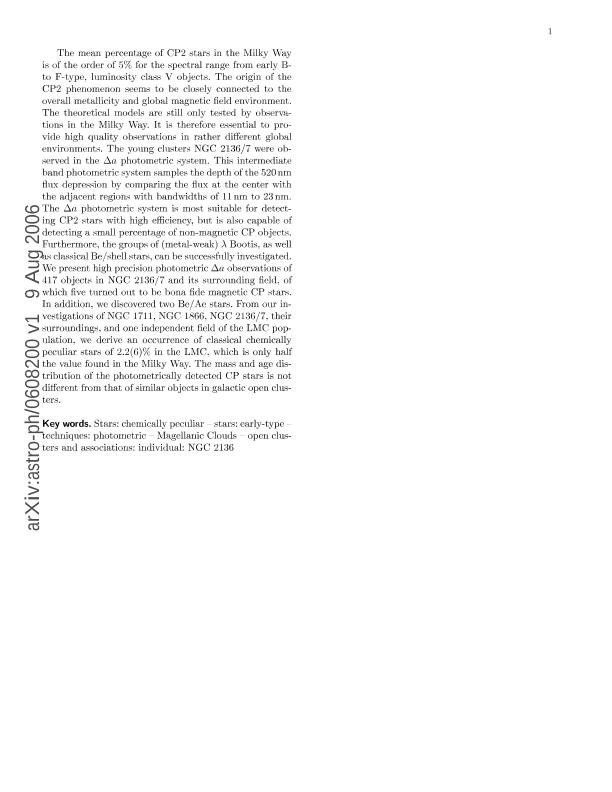Mostrar el registro sencillo del ítem
dc.contributor.author
Paunzen, E.
dc.contributor.author
Maitzen, H.M.
dc.contributor.author
Pintado, Olga Ines

dc.contributor.author
Claret, A.
dc.contributor.author
Iliev, I.Kh.
dc.contributor.author
Netopil, M.
dc.date.available
2020-03-13T19:27:56Z
dc.date.issued
2006-12
dc.identifier.citation
Paunzen, E.; Maitzen, H.M.; Pintado, Olga Ines; Claret, A.; Iliev, I.Kh.; et al.; Chemically peculiar stars in the Large Magellanic Cloud; EDP Sciences; Astronomy and Astrophysics; 459; 3; 12-2006; 871-874
dc.identifier.issn
0004-6361
dc.identifier.uri
http://hdl.handle.net/11336/99545
dc.description.abstract
Context. The detection of magnetic chemically peculiar (CP2) stars in open clusters of extragalactic systems can give observational answers to many unsolved questions. For example, one can study the influence of different global as well local environments on the lack of and presence of peculiarities. Aims. The mean percentage of CP2 stars in the Milky Way is of the order of 5% for the spectral range from early B- to F-type, luminosity class V objects. The origin of the CP2 phenomenon seems to be closely connected to the overall metallicity and global magnetic field environment. The theoretical models are still only tested by observations in the Milky Way. It is therefore essential to provide high quality observations in rather different global environments. Methods. The young clusters NGC 2136/7 were observed in the Δa photometric system. This intermediate band photometric system samples the depth of the 520 nm flux depression by comparing the flux at the center with the adjacent regions with bandwidths of 11 nm to 23 nm. The Δa photometric system is most suitable for detecting CP2 stars with high efficiency, but is also capable of detecting a small percentage of non-magnetic CP objects. Furthermore, the groups of (metal-weak) λ Bootis, as well as classical Be/shell stars, can be successfully investigated. Results. We present high precision photometric Δa observations of 417 objects in NGC 2136/7 and its surrounding field, of which five turned out to be bona fide magnetic CP stars. In addition, we discovered two Be/Ae stars. Conclusions. From our investigations of NGC 1711, NGC 1866, NGC 2136/7, their surroundings, and one independent field of the LMC population, we derive an occurrence of classical chemically peculiar stars of 2.2(6)% in the LMC, which is only half the value found in the Milky Way. The mass and age distribution of the photometrically detected CP stars is not different from that of similar objects in galactic open clusters. © ESO 2006.
dc.format
application/pdf
dc.language.iso
eng
dc.publisher
EDP Sciences

dc.rights
info:eu-repo/semantics/openAccess
dc.rights.uri
https://creativecommons.org/licenses/by-nc-sa/2.5/ar/
dc.subject
GALAXIES: MAGELLANIC CLOUDS
dc.subject
STARS: CHEMICALLY PECULIAR
dc.subject
STARS: EARLY-TYPE
dc.subject
TECHNIQUES: PHOTOMETRIC
dc.subject.classification
Astronomía

dc.subject.classification
Ciencias Físicas

dc.subject.classification
CIENCIAS NATURALES Y EXACTAS

dc.title
Chemically peculiar stars in the Large Magellanic Cloud
dc.type
info:eu-repo/semantics/article
dc.type
info:ar-repo/semantics/artículo
dc.type
info:eu-repo/semantics/publishedVersion
dc.date.updated
2020-03-11T18:34:07Z
dc.journal.volume
459
dc.journal.number
3
dc.journal.pagination
871-874
dc.journal.pais
Francia

dc.description.fil
Fil: Paunzen, E.. Institut Fur Astronomie, Vienna; Austria
dc.description.fil
Fil: Maitzen, H.M.. Institut Fur Astronomie, Vienna; Austria
dc.description.fil
Fil: Pintado, Olga Ines. Consejo Nacional de Investigaciones Científicas y Técnicas; Argentina. Consejo Nacional de Investigaciones Científicas y Técnicas. Centro Científico Tecnológico Conicet - San Juan. Complejo Astronómico "El Leoncito". Universidad Nacional de Córdoba. Complejo Astronómico "El Leoncito". Universidad Nacional de la Plata. Complejo Astronómico "El Leoncito". Universidad Nacional de San Juan. Complejo Astronómico "El Leoncito"; Argentina
dc.description.fil
Fil: Claret, A.. Instituto de Astrofísica de Andalucía - Csic;
dc.description.fil
Fil: Iliev, I.Kh.. National Astronomical Observatory; Bulgaria
dc.description.fil
Fil: Netopil, M.. Institut Fur Astronomie, Vienna; Austria
dc.journal.title
Astronomy and Astrophysics

dc.relation.alternativeid
info:eu-repo/semantics/altIdentifier/url/https://www.aanda.org/articles/aa/pdf/2006/45/aa5333-06.pdf
dc.relation.alternativeid
info:eu-repo/semantics/altIdentifier/doi/https://doi.org/10.1051/0004-6361:20065333
Archivos asociados
